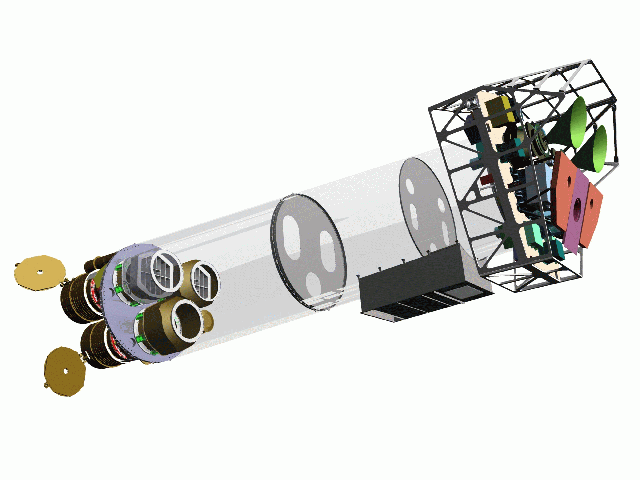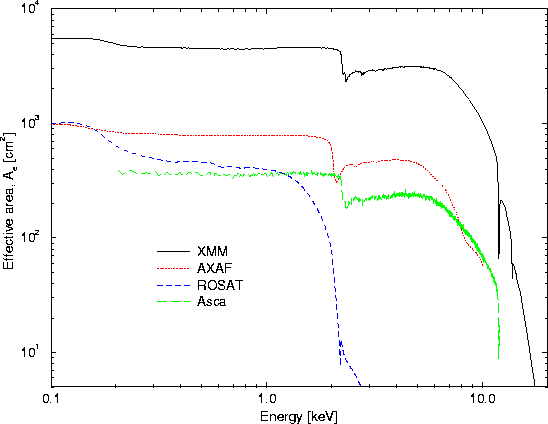XMM-NEWTON OVERVIEW

-
(From the VILSPA XMM-Newton Science Operations Center, courtesy of Dornier
Satellitensysteme GmbH.)
In the above figure, the three X-ray mirror modules are visible at the lower left end of the telescope, two of which have Reflection Grating Arrays. At the right end of the telescope is the focal-plane instrumentation: The Epic MOS cameras with their radiators (black with green "horns"), the radiator of the EPIC PN camera (violet) and those of the RGS cameras (orange). The black box at the bottom of the telescope tube is the outgassing device.
XMM-Newton with its three telescope modules is the most sensitive imaging X-ray observatory in the 250 eV to 12 keV energy range ever flown. The combination of the CCD cameras, grating spectrometer, and high angular resolution replicated nickel mirrors with gold coating provides exceptional spectral and imaging capabilities to study astrophysical sources. The following table provides a general overview of the XMM-Newton specifications.
| XMM-Newton Characteristics | ||
|---|---|---|
| Focal Length | | 7.5 m |
| EPIC | Energy Range | 0.1 - 15.0 keV |
| | | 1 - 100 ┼ |
| | Effective Area | 75 cm▓ @ 12 keV |
| | | 950 cm▓ @ 8 keV |
| | | 1620 cm▓ @ 6 keV |
| | | 1475 cm▓ @ 2.5 keV |
| | | 2485 cm▓ @ 1.5 keV |
| | | 1650 cm▓ @ 0.6 keV |
| | | 595 cm▓ @ 0.25 keV |
| | Angular Resolution | 15 arc seconds HEW |
| | |
6 arc seconds FWHM |
| | Field of View | ~30 arc minutes |
| RGS | Energy Range | 0.4 - 2.5 keV |
| | Effective Area | 160 cm▓ @ 1.5 keV |
| | | 94 cm▓ @ 0.6 keV |
| | Spectral Resolution | E/dE~150-800 |
| Optical Monitor | Telescope | 30 cm diameter |
| | Wavelength range | 1700-5500 ┼ |
| | Field of View | 17 x 17 arc minutes |
The following figure compares the XMM-Newton mirror areas with those of other recent X-ray observatories (note that the detector efficiency has not been included). The figure clearly shows the greater area and extended energy range of XMM-Newton compared to ROSAT, ASCA, and even Chandra.

If you have any questions concerning XMM-Newton send email to xmmhelp@athena.gsfc.nasa.gov



